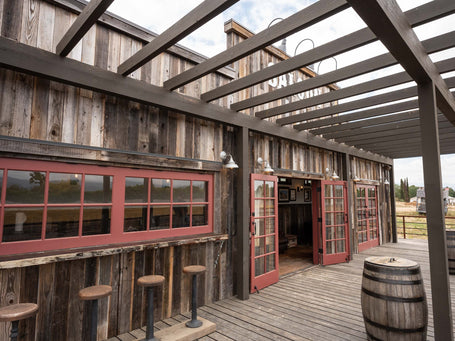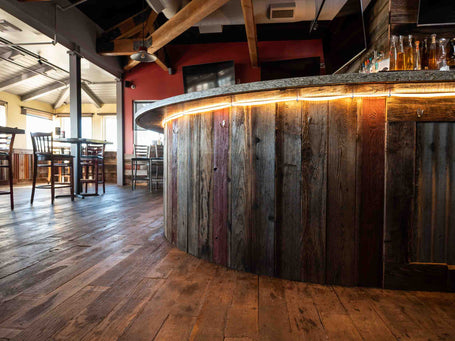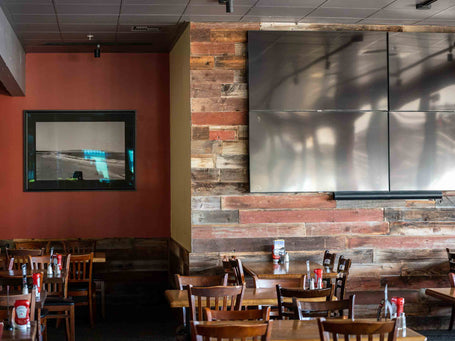Introduction
As environmental concerns continue to rise, the demand for sustainable building materials has never been greater. Reclaimed wood and new lumber both offer unique benefits, but when it comes to sustainability, reclaimed wood stands out as the superior choice. At Huasna, we are committed to promoting the use of reclaimed wood to help reduce environmental impact and promote sustainable living. This article explores the differences between reclaimed wood and new lumber, focusing on their respective impacts and the sustainability benefits of choosing reclaimed wood.
Environmental Impact
Reclaimed Wood
Resource Conservation:Reclaimed wood is sourced from existing structures such as barns, factories, and homes that are no longer in use. By repurposing this wood, we conserve natural resources and reduce the need for new lumber. This practice helps preserve forests and the biodiversity they support.
Lower Carbon Footprint:The process of harvesting, processing, and transporting new lumber contributes significantly to greenhouse gas emissions. In contrast, reclaimed wood has already undergone these processes, resulting in a much lower carbon footprint. According to the U.S. Environmental Protection Agency (EPA), using reclaimed wood can reduce carbon emissions by up to 75% compared to new lumber.
Waste Reduction:Reclaimed wood helps divert waste from landfills. The construction and demolition industry generates millions of tons of waste annually, and repurposing wood from old structures helps mitigate this problem. This practice supports a circular economy where materials are reused and repurposed, reducing overall waste.
New Lumber
Deforestation:The production of new lumber often involves cutting down trees from forests, contributing to deforestation. This practice leads to habitat loss, decreased biodiversity, and increased carbon emissions. The World Wildlife Fund estimates that deforestation accounts for approximately 15% of global greenhouse gas emissions.
Energy Consumption:Harvesting and processing new lumber require significant energy inputs. From logging operations to milling and transportation, the production of new lumber consumes large amounts of fossil fuels, contributing to air pollution and climate change.
Chemical Treatments:New lumber is often treated with chemicals to enhance its durability and resistance to pests and decay. These treatments can include formaldehyde, arsenic, and other toxic substances, which can off-gas into the environment and negatively impact air and water quality.
Economic and Social Impact
Reclaimed Wood
Supporting Local Economies:The reclaimed wood industry often relies on local sources and small businesses for the collection, processing, and distribution of materials. This supports local economies by providing jobs and promoting economic growth within communities. Additionally, purchasing reclaimed wood from local suppliers reduces transportation costs and emissions.
Preserving Historical Resources:Reclaimed wood often comes from old barns, factories, and other historical structures. By repurposing this wood, we preserve a piece of history and honor the craftsmanship of the past. This connection to history adds cultural value to reclaimed wood products and enriches our understanding of architectural heritage.
New Lumber
Economic Growth:The production and sale of new lumber contribute to economic growth, providing jobs in forestry, manufacturing, and retail. However, this growth can come at the expense of environmental sustainability and long-term resource availability.
Community Impact:Deforestation and unsustainable logging practices can have negative impacts on local communities, including displacement of indigenous peoples, loss of livelihoods, and degradation of natural resources. Sustainable forestry practices are essential to mitigate these impacts, but they are not always implemented.
Aesthetic and Practical Benefits
Reclaimed Wood
Unique Character and Beauty:Each piece of reclaimed wood has its own unique story, reflected in its weathered texture, patina, and historical marks. This uniqueness adds a rustic charm and authenticity to any project, making reclaimed wood a sought-after material for interior design.
Durability and Stability:Reclaimed wood is often more durable and stable than new wood because it has been seasoned and weathered over time. This makes it less prone to warping, shrinking, or cracking, ensuring that your reclaimed wood projects will stand the test of time.
New Lumber
Uniformity:New lumber offers a uniform appearance and consistency, making it easier to work with for certain applications. This can be advantageous for projects that require precise measurements and a more modern aesthetic.
Availability:New lumber is widely available and can be sourced in large quantities, making it a convenient choice for large-scale construction projects. However, this convenience comes at the cost of increased environmental impact.
Why Choose Huasna?
At Huasna, we are dedicated to providing high-quality reclaimed wood that supports sustainability and enhances your home’s aesthetic appeal. Our barn wood planks are sourced from authentic structures, ensuring each piece carries its own unique history and character. We prioritize sustainability and quality, offering materials that are both environmentally friendly and built to last.
Whether you're a DIY enthusiast, a professional designer, or someone who values sustainable living, Huasna is here to help you make responsible choices that benefit the planet and society. Explore our collection of reclaimed wood and discover how it can transform your space into a haven of warmth, history, and sustainability.






